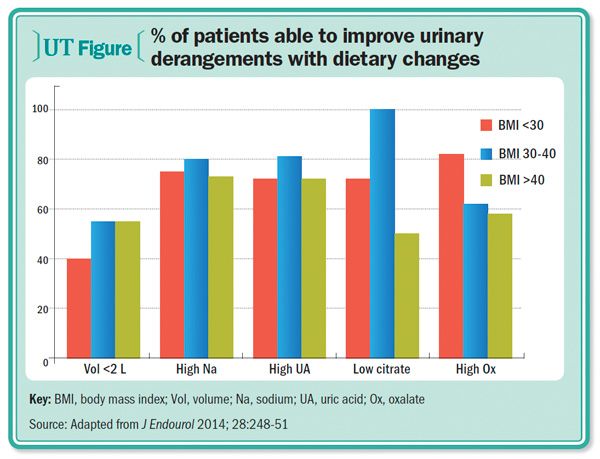Article
How to prevent stone formation in patients with metabolic syndrome
Author(s):
This article examines the relationship between the metabolic syndrome and kidney stone disease. We explain elements of the metabolic workup and practical strategies for prevention and management of stones in patients with the metabolic syndrome.



Kidney stone disease is a common and widespread condition with a high prevalence in both males and females. According to a recent cross-sectional analysis of large epidemiologic data from the National Health and Nutrition Examination Survey (NHANES) 2007-2010, the prevalence of the disease has steadily increased over the past few decades. From the same database but for the period between 1976 and 1980, the prevalence rose from 4.9% to 10.6% in men and from 2.8% to 7.1% in women. On average, one in 11 Americans will develop at least one kidney stone in their lifetime (Eur Urol 2012; 62:160-5). Whether this increment represents better and earlier diagnosis of the disease, dietary and lifestyle changes, and/or climate influences remains a matter of discussion.
Similarly, obesity and weight gain are considered by many a rising epidemic in our society. These conditions seem to have a direct relationship with an entity initially described in the late 1980s as syndrome X and later defined as metabolic syndrome. Metabolic syndrome is known to be a risk factor for multiple systemic and chronic diseases now affecting at least up to 25% of the U.S. population, with comparable numbers in other industrialized nations (J Am Coll Cardiol 2013; 62:697-703).
This article examines the relationship between the metabolic syndrome and kidney stone disease. We explain elements of the metabolic workup and practical strategies for prevention and management of stones in patients with the metabolic syndrome. As will be evident from the article, a multidisciplinary approach incorporating the expertise of a nephrologist, dietitian, and urologist can be of great benefit for these patients.
Metabolic syndrome defined
The following components are considered for the definition of the metabolic syndrome:
- elevated waist circumference
- elevated triglycerides (≥150 mg/dL) or treatment with medication for the condition
- reduced HDL cholesterol (<40 mg/dL in males, <50 mg/dL in females) or treatment with medication for the condition
- elevated blood pressure (systolic ≥130 and/or diastolic ≥85 mm Hg) or treatment for hypertension
- elevated fasting glucose (≥100 mg/dL) or drug treatment for elevated glucose.
It is now widely accepted that people in whom at least three of these five components are present qualify as having the metabolic syndrome (Circulation 2009; 120:1640-5). Nephrolithiasis, once thought of as an isolated condition, has gained recognition as a systemic and chronic disease associated with and directly correlated to the metabolic syndrome (Am J Kidney Dis 2011; 58:383-8). Higher prevalence rates of uric acid stones in patients with the metabolic syndrome are well documented. These may be caused by increased net acid excretion and impaired buffering caused by defective urinary ammonium excretion thought to be the result of defective insulin signaling and/or possibly fat accumulation in renal cells, a process known as lipotoxicity (Semin Nephrol 2008; 28:174-80).
However, independent of other factors of the metabolic syndrome or diabetes, high total cholesterol and triglycerides have also been associated with an increased risk of uric acid kidney stone formation (J Urol 2014; 191:667-72). Despite this, calcium-based kidney stones remain the most common type.
Continue to the next page for more.
The metabolic workup
People with the metabolic syndrome, particularly those with obesity, pose a challenge in management and control of nephrolithiasis recurrence. We recommend a full metabolic workup in patients who have both conditions. Although no randomized controlled trials are available to support this suggestion, it is widely recommended in patients with severe or multiple comorbidities that may predispose for recurrence or complications of the disease (Urol Clin North Am 2013; 40:13-20). All of these subjects should have baseline kidney function tests, including electrolytes with serum calcium and phosphorus, uric acid, and urine analysis (Metabolic Evaluation: Underuse or Overdone? In: Practical Controversies in Medical Management of Stone Disease. New York, Springer Science+Business Media, 2014: 1-6). By the same token, 24-hour urine collections should be performed at least once, particularly in morbidly obese patients, 98% of whom have at least one lithogenic risk factor (J Urol 2008; 179:1401-6). Stone composition analysis should always be done after either a urologic procedure or spontaneous passage.
Every patient with known urolithiasis should have imaging studies, if not previously performed in an emergency department, to determine stone location and burden. Taking into consideration the abdominal girth and higher incidence of radiolucent stones (by standard KUB) in patients with the metabolic syndrome, as well as the greater difficulty to obtain images by ultrasonography, a lower threshold to obtain CT scans in these patients should be exercised.
Primary prevention
It has been shown that primary prevention in patients at high risk for stone formation is cost effective. General interventions, as in any other patient with kidney stone disease, should be encouraged.
Water intake. Such interventions include inexpensive and well-proven treatments as simple as increased water intake to effect up to 2.5 liters of urinary output daily. Although there is much debate about the intake of fluids other than water, it has been demonstrated that higher consumption of sugar-sweetened sodas and punch is associated with an increased risk of kidney stones (Clin J Am Soc Nephrol 2013; 8:1389-95). Restriction of such fluids should be highly encouraged in patients with both conditions, as consumption of beverages with higher contents of sugar and fructose also may worsen visceral obesity, fasting glucose, and triglyceride levels (all part of the metabolic syndrome), and higher refined carbohydrate diets have also been associated with increased urinary calcium excretion.
Diet. Similarly, lower ingestion of salt, specifically a sodium target of ≤2,000 mg/day, should also be recommended. This may have a dual effect in the management of elevated blood pressure and decreased levels of hypercalciuria, the latter being the most common abnormal metabolic risk factor encountered in patients with kidney stones. The DASH (Dietary Approaches to Stop Hypertension)-style diet, which is high in fruits and vegetables, moderate in low-fat dairy products, and low in animal protein, has been shown to decrease the risk for kidney stones despite the theoretical increase in foods with higher oxalate content (J Am Soc Nephrol 2009; 20:2253–9). The DASH diet has also been shown to lower blood pressure.
Exercise. One overlooked aspect of counseling in patients with both conditions is exercise. Although scarce data is available to show the beneficial effects of regular exercise in patients with kidney stones, recent data from a large, prospective, longitudinal multicenter study in postmenopausal women help confirm these beneficial effects. Incident stones were reduced up to 31% in patients undergoing moderate to high physical activity (J Am Soc Nephrol 2014; 25: 362–9). Although these results pertain to postmenopausal women specifically, one could extrapolate the same results to premenopausal women or males. Even if this is not a currently proven fact, the effects in all other aspects of the metabolic syndrome should be good enough to reinforce this intervention to all patients.
When a metabolic evaluation is performed, it is reasonable to ask whether a patient with metabolic syndrome will comply with dietary recommendations. Our group recently evaluated this question in a study of 214 patients, 29% of whom were obese and 12% of whom were morbidly obese. At a mean follow-up of 10 months, obese stone formers were as successful as those with normal body mass index at improving their diet to optimize their urinary risks (figure), and these changes also led to a decrease in BMI in those who were obese (J Endourol 2014; 28:248-51).

Continue to the next page for more.
Medical management
In patients with the metabolic syndrome and recurrent kidney stones, aggressive medical treatment for stone prevention-in addition to the interventions mentioned above-should be instituted. First-line therapy should be a thiazide diuretic with dual intention to treat both elevated blood pressure and hypercalciuria if the latter is present in the 24-hour urine collection. Regardless of this finding, empiric treatment with these medications may still be considered. Special attention should be given to side effects such as hypokalemia, as these patients tend to have elevated aldosterone levels.
Also, lipid and glucose levels should be followed, as these are common side effects of thiazide diuretics (J Urol 2007; 177:1238-43). Higher doses of thiazides for prevention of kidney stones may be required than are administered for the treatment of hypertension alone. In patients with known uric acid kidney stones or in those with decreased urinary pH and an unknown type of stone, potassium citrate (Urocit-K) should be used first with a goal to alkalinize the urine to a pH ≥6.5-7.0. Other interventions may be tailored to findings in the metabolic workup such as allopurinol (Zyloprim) for patients with hyperuricosuria or hyperuricemia, even in the absence of gout.
In patients in whom bariatric surgery is considered for management of morbid obesity and its associated comorbidities, preoperative counseling about the increased risk of calcium oxalate kidney stones is required. In those already known to be stone formers, earlier interventions with goals for higher urinary outputs, higher calcium-containing diets, and lower oxalate consumption should be recommended. This may be difficult in the long term and even more in the immediate postoperative period due to the restrictive effects of the small gastric pouch. Closer vigilance for stone recurrence in these patients should also be exercised and use of supplemental calcium, particularly with meals, should be attempted to decrease absorption of oxalate. The use of oral Oxalobacter formigenes is on the horizon as a possible alternative for management of this complication.
Conclusions
Both kidney stones and metabolic syndrome are on the rise. There seems to be a direct correlation between the two entities. Patients with both conditions warrant a more detailed evaluation than the general population, as they also have higher rates of stone recurrence and complicated manifestations. A multidisciplinary approach should be in place for such patients to address not only medications and surgical procedures, but also to emphasize major dietary and lifestyle changes. Such a team approach should include a urologist, nephrologist, and even dietitian for counseling. Medical management should address particular issues, as higher rates of uric acid kidney stones are encountered in this population.UT
More Hands On articles
The azoospermic male: Contemporary evaluation and treatment
How to talk to patients about prostate cancer screening
How to manage post-prostatectomy incontinence
Subscribe to Urology Times to get monthly news from the leading news source for urologists.

















